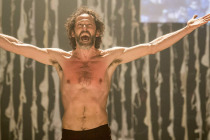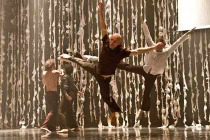18 Belgrade Dance Festival
Zappalà Danza - Catania, Italy
Book & Buy TicketsA.Semu tutti devoti tutti?
choreography, direction, set, light design: Roberto Zappalà
original music, live played: Puccio Castrogiovanni (I Lautari)
music: Dire Straits, Rosario Miraggio, Gustav Mahler, Burt Bacharach
dramaturgy: Nello Calabrò, Roberto Zappalà
costumes design: Marella Ferrera, Roberto Zappalà
text: Nello Calabrò
realization of sets and costumes: Debora Privitera
photography: Serena Nicoletti, Giuseppe Distefano
duration: 75’
premiere: Teatro Stabile Catania, 2019
dancers: Adriano Coletta, Alain El Sakhawi, Alberto Gnola, Salvatore Romania, Fernando Roldan Ferrer, Antoine Roux-Briffaud, Massimo Trombetta, Valeria Zampardi
musicians: Giovanni Allegra, bass | Puccio Castrogiovanni, strings, jew’s harps and accordion | Salvo Farruggio, percussions | Peppe Nicotra, guitars
video direction: Nello Calabrò, Roberto Zappalà
performer: Carmen Consoli
rehearsal director: Ilenia Romano
technical coordination: Sammy Torrisi
sound: Salvo Noto
production, tour management: Maria Inguscio
coproduction: Scenario Pubblico/ Compagnia Zappalà Danza – Centro Nazionale di Produzione della Danza, Teatro Stabile di Catania
in collaboration with: MilanOltre Festival
supported by: Ministry for Culture, Region of Sicily
A piece dedicated to the patron Saint of Catania, Saint Agatha, deprived of her breasts as a punishment for her refusal to get married with the city Proconsul and executed in 251 A.D., and to the huge feast and procession in her honor, among the largest in the Christian-Catholic world. Adopting an iconographic apparatus, extremely contemporary, the dance work tackles, with a universal language, current issues such as violence against women, and religious and economic fundamentalism. Sicily is depicted in between fascination, mysticism and harsh reality. The Saint, whose devotional image bordering eroticism and sadism (the pincers, the mangled breasts) is universally known in the catholic world, is a ‘mere’ starting point. The archaic and, concurrently, contemporary setting of the religious celebration shows the contradictions of a world where Saint Agatha’s martyrdom symbolizes a more universal martyrdom and that identifies the martyr with its city and its people. While the performance has neither the presumption nor the capability to “investigate all aspects… all angles…, from all perspectives” - as in Borges’ novel “El Aleph” it does aim at showing who we are, we were and we risk to become. The pure and powerful dance of Roberto Zappalà portraits the ambivalence of the procession of Saint Agatha, between sacred and profane, spirituality and illegality, fiction and devotion, love and fury, redemption and exploitation, all aspects that coexist and in which the individual blissfully loses itself inside the crowd. “A.semu tutti devoti tutti?” arises from the need to deal with a series of crucial aspects of what living in a community and being part of it means, investigating and eviscerating the feeling of belonging that a secularized and media-obsessed society expresses towards God, religion, religiousness, and the transcendental. This relationship is revealed in two opposite and complementary aspects: a private and a public one. Two faces of the same coin revealing a deep ambiguity hard to clarify. Believers (Sicilian or not) seem to be doomed by the paradox of publicly showing their mystical fervor and devotion as the only way to prove their belief. In doing so, however, their very own belief is jeopardized: misrepresented or denied. The piece’s container is the project “Re-mapping Sicily” - a personal re-reading of Sicily through Zappalà’s unique artistic vocabulary that does not leave out of the picture popular belief, an aspect that permeates Sicily and Italy itself, becoming the key to understand nearly everything in the society. In light of the recent success of the new 2019 staging, ten years after the premiere, the piece confirms the newness of its content, still actual when addressing the power dynamics behind the Catanese feast. Live music played by Lautari, an evocative backdrop consisting of 1,600 bras stitched and hanged, and 7 men carrying the body of the Saint in triumph, are the background to the paradoxical message contained in the title: a lay reflection upon fundamentalisms that obscure society and faith.
Founded in Catania in 1989 by choreographer Roberto Zappalà, and regularly supported since 1996 by the Italian Ministry of Culture and the Region of Sicily, the Zappalà Danza is considered one of the most interesting contemporary dance companies working today in Italy. The story of the company is tightly bound to the figure of Roberto Zappalà, whose choreographic style, after years of research on movement together with his dancers, has become an original and versatile language. The company has developed partnerships with important organizations in Italy, making possible the production process and tours all over the country, but also in Europe, USA, South America, Middle East and South Africa. Zappalà Danza distinguish itself for the availability of a wide and articulated repertory, result of the synergistic and prolific work of Roberto Zappalà and the dramaturge Nello Calabrò, who traced together in the last ten years a projected path in continuous expansion, allowing the realization of productions of different typology, from creations for a few dancers to those with the entire company, most of them with live music. Since 2002, the company is resident at Scenario Pubblico, inspiring space in Catania. The new location has allowed the company and the choreographer to extend and to deepen their research, embedding in the Sicilian territory not only with the productive and performing activity but also with MoDem codici gestuali, a structure promoting the spread of the company’s language. In 2015, Zappalà Danza together with Scenario Pubblico has been recognized by the Italian Ministry of Culture as National Dance Production Centre, with only two other Italian structures.
It is a dance of powerful, sensational collisions, with self-flagellation and processions, frenzies and a craving for ecstasy.
© Il Manifesto
Absolute aesthetics, in a perfect equilibrium between the search for truth and its representation.
© Sipario
An all-male dance, full of energy, but also obsessive, hysteric, now fast, now slowed down, saturated with fanatism, just like the procession for the martyr.
© La Stampa
A power of conception that leaves astonished.
© La Sicilia




